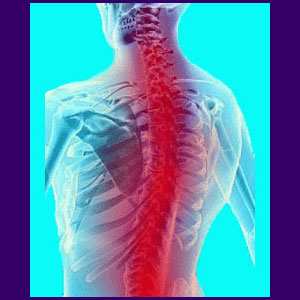
The neurological consequences of back pain can range from minor to debilitating. Neurological expressions include pain, but also include a variety of other expressions in both symptomology and specific system dysfunction. We have already detailed many of the possible neurological effects of various back pain conditions in individual essays, but will now take the opportunity to discuss the “”big picture” of neurological consequences and how these related to indicated and recommended treatments.
The nerves in our bodies are responsible for transmitting all the sensory messages we experience. Nerves are also responsible for allowing the exhaustive range of motor functionality that we enjoy as human beings. Finally, nerves also work below the conscious surface by relaying messages between the brain and various autonomic systems of the body that are not consciously controlled. The neurological consequences of dorsalgia can affect any or all of these nerve types, enacting wide-ranging effects on health and physical ability.
This treatise explains how specific back pain diagnoses might create nerve effects throughout the anatomy. If you have questions about why you suffer specific nerve symptoms in relation to a back pain condition, this is the right article for you.
Sensory Neurological Consequences of Back Pain
Many dorsalgia patients suffer far more diverse expressions than just pain. These additional sensory experiences result from particular interactions between the sensory nerves and the causative condition or mechanism. Some of the most commonly reported additional symptoms of back pain include burning, tingling (also called pins and needles or paresthesia), numbness or weakness. Additionally, the texture of pain is a result of the causative process interacting with the sensory nerves, producing symptoms that might be described as focal, stabbing, radiating, dull, sharp, liquid-like or widespread.
Sensory symptoms can result from full or partial spinal nerve root compression scenarios, muscular interactions with nerves, localized nerve trauma or ischemia of particular nerve tissues.
Neurological Consequences of Back Pain on Motor Function
Motor functionality is also commonly affected by dorsalgia, through neurological, inflammatory and mechanical consequences of back pain. When it comes to nerves, motor function can be affected through nerve root compression within the spinal anatomy, localized peripheral nerve compression throughout the body, or ischemia which might be caused by a variety of structural, systemic or mindbody sources.
Common and uncommon consequences of motor function issues include foot drop, also called dorsiflexion deficit, frozen shoulder or hip conditions, incontinence of bladder and/or bowels due to mechanical dysfunction, constipation, objective weakness and reduction in effective range of motion.
Neurological Consequences of Back Pain on Autonomic Function
Autonomic functionality occurs beneath the level of consciousness, but it is not automatic. Instead, it is actively and continually controlled by subconscious and unconscious aspects of the brain, with messages sent along special autonomic nerves that can also be affected by back pain issues.
Many autonomic nerves (the cranial nerves) do not travel the spine and are therefore not subject to the usual spinal sources of compression. However, spinal issues can cause widespread postural and functional issues in full body musculature that might lead to compression of one or more of the cranial nerves in transit between the brain and the destination system. Additionally, ischemia is frequently found to act on these cranial nerves and on the vagus nerve, in particular.
Other autonomic nerves do travel the spine and are found to exit at the mid and lower sacral levels. These can be affected by spinal compression conditions, such as cauda equina syndrome, local damage or compression after they leave the spine, disease process or ischemia.
Autonomic nerve compression or oxygen deprivation can cause failure of very important bodily systems, including heart beat, organ functions, breathing, digestion and waste regulation and many, many more. In fact, there are still many aspects of the autonomic system that are enigmatic and undiscovered by medical science.
Neurological Consequences of Back Pain on Treatment
We caution all readers that the medical system has become overly compartmentalized. Many conditions are not diagnostically linked to their actual origin and therefore become treatment-defiant. For many seemingly unrelated symptoms, a diversity of treatments might be used, but none target the singular root causative mechanism for the entirely of suffering to exist.
Therefore, patients are warned to remind their doctors to keep the big picture of health in mind when diagnosing how many different symptoms may be inherently linked to a singular structural spinal, structural nonspinal, disease-related, systemic or mindbody source, for best treatment outcomes.
Back Pain > Back Pain Symptoms > Neurological Consequences of Back Pain





